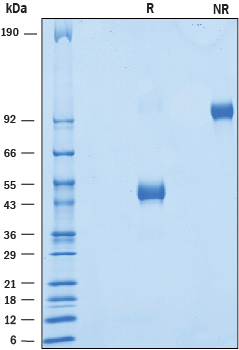Recombinant Human VSIG3 C-Terminal Fc Chimera Protein, CF Summary
Product Specifications
| Human VSIG3 (Pro144-Gly241) Accession # Q5DX21 | IEGRMD | Human IgG1 (Pro100-Lys330) |
| N-terminus | C-terminus | |
Analysis
Product Datasheets
Carrier Free
CF stands for Carrier Free (CF). We typically add Bovine Serum Albumin (BSA) as a carrier protein to our recombinant proteins. Adding a carrier protein enhances protein stability, increases shelf-life, and allows the recombinant protein to be stored at a more dilute concentration. The carrier free version does not contain BSA.
In general, we advise purchasing the recombinant protein with BSA for use in cell or tissue culture, or as an ELISA standard. In contrast, the carrier free protein is recommended for applications, in which the presence of BSA could interfere.
10075-VS
| Formulation | Lyophilized from a 0.2 μm filtered solution in PBS. |
| Reconstitution | Reconstitute at 200 μg/mL in PBS. |
| Shipping | The product is shipped at ambient temperature. Upon receipt, store it immediately at the temperature recommended below. |
| Stability & Storage: | Use a manual defrost freezer and avoid repeated freeze-thaw cycles.
|
Scientific Data
 View Larger
View Larger
Recombinant Human VSIG3 C-Terminal Fragment Fc Chimera (Catalog # 10075-VS) inhibits anti-CD3 antibody induced IFN-gamma secretion by human peripheral blood mononuclear cells. The ED50 for this effect is 1-6 μg/mL.
 View Larger
View Larger
2 μg/lane of Recombinant Human VSIG3 C-Terminal Fragment was resolved with SDS-PAGE under reducing (R) and non-reducing (NR) conditions and visualized by Coomassie® Blue staining, showing bands at 41-51 kDa and 80-100 kDa, respectively.
Reconstitution Calculator
Background: VSIG3
VSIG3, also known as IGSF11, BT-IgSF, and CLMP, is an approximately 50 kDa transmembrane adhesion protein (1). Mature human VSIG3 consists of a 219 amino acid (aa) extracellular domain (ECD), a 21 aa transmembrane segment, and a 169 aa cytoplasmic domain (2). Within the ECD, human VSIG3 shares 95% aa sequence identity with mouse and rat VSIG3. Human ECD contains two tandem Ig-like domains, and this product includes only the C-terminal Ig-like domain (aa 144-241). Alternative splicing generates additional isoforms with a substituted signal peptide that may also have a deletion in the second Ig-like domain (3). VSIG3 is expressed on epithelial and endothelial cells, neurons and glial cells, and platelets (2-4). It localizes to epithelial tight junctions and mediates homophilic in trans cell adhesion (3-5). VSIG3 also localizes to neuronal postsynaptic densities where it recruits the GluA1 and GluA2 subunits of AMPA receptors and supports excitatory synaptic transmission (6). The short isoform can be up-regulated in gastric cancer (7). In zebrafish, VSIG3 is expressed in melanophores and plays a role in the development and patterning of pigment cells (8).
- Schreiber, J. et al. (2014) Adv. Neurobiol. 8:21.
- Suzu, S. et al. (2002) Biochem. Biophys. Res. Commun. 296:1215.
- Katoh, M. and M. Katoh (2003) Int. J. Oncol. 23:525.
- Raschperger, E. et al. (2004) J. Biol. Chem. 279:796.
- Harada, H. et al. (2005) J. Cell. Physiol. 204:919.
- Jang, S. et al. (2016) Nat. Neurosci. 19:84.
- Watanabe, T. et al. (2005) Cancer Sci. 96:498.
- Eom, D.S. et al. (2012) PLoS Genet. 8:e1002899.
FAQs
No product specific FAQs exist for this product, however you may
View all Proteins and Enzyme FAQsReviews for Recombinant Human VSIG3 C-Terminal Fc Chimera Protein, CF
There are currently no reviews for this product. Be the first to review Recombinant Human VSIG3 C-Terminal Fc Chimera Protein, CF and earn rewards!
Have you used Recombinant Human VSIG3 C-Terminal Fc Chimera Protein, CF?
Submit a review and receive an Amazon gift card.
$25/€18/£15/$25CAN/¥75 Yuan/¥1250 Yen for a review with an image
$10/€7/£6/$10 CAD/¥70 Yuan/¥1110 Yen for a review without an image
